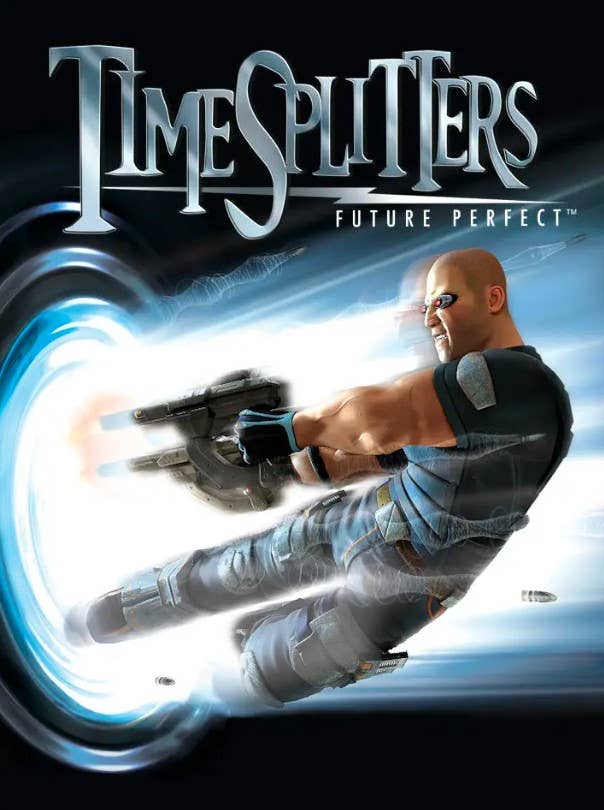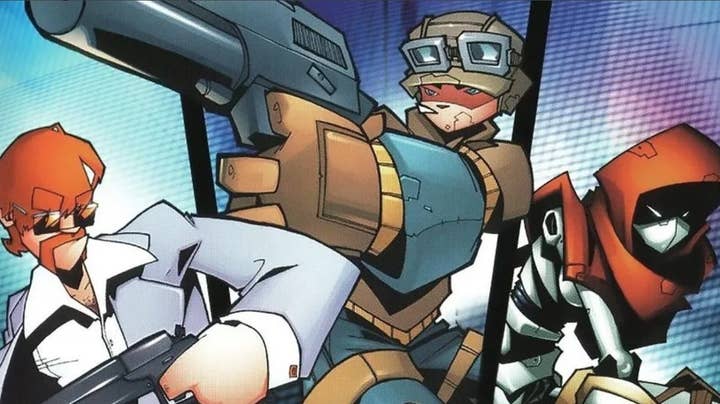The story of TimeSplitters Next and Free Radical Design 2.0
Steve Ellis, the two times founder of Free Radical Design, takes us through the return of TimeSplitters that never was
I was eagerly awaiting the return of TimeSplitters.
For those that don't know the franchise, it was a first-person shooter series that debuted at the launch of PS2. It was the first game by Free Radical Design, a team formed by the creators of GoldenEye and Perfect Dark, including Steve Ellis, David Doak, Karl Hilton, and Graeme Norgate.
The first TimeSplitters was a hit, but it was the second one that proved the real critical darling and breakthrough success. A third game, TimeSplitters: Future Perfect, arrived in 2005 and was another strong outing, but didn't quite reach the levels of its predecessor.
Free Radical's story takes a downward turn from there. The disappointing launch of its new IP Haze, followed by a publishing deal that went south, sent the company into bankruptcy in 2008.
And TimeSplitters lay dormant until, in 2018, Koch Media (now Plaion) acquired the rights to the franchise.
"I was on holiday at the time [that story came out]," recalls Steve Ellis. "I didn't really know who they were. But it being TimeSplitters, I felt I ought to find out what they [were] doing. So I got in touch with Klemens [Kundratitz, CEO], went to see him, and said 'why don't we do something?'

"I don't think they really had a plan of what to do. But they wanted to do something. I suggested we set up a new team and make a new game, and it went from there."
Ellis was given a small budget to build a prototype for what a new TimeSplitters might look like, so he hired a small team. Then COVID-19 hit.
"We had seven or eight people, who were mostly graduates, and we had to send them all home," he recalls. "I remember driving them around and taking their PCs to their houses. We naively thought that it might last for a few weeks. As it turned out, we would spend the next two years working from home and building the team.
"It wasn't the ideal start. But it went reasonably well. Having that bit of time together in the office [before lockdown] was useful. At least that core of the team knew each other quite well.
"We had about 14 people by the end of the prototype period, and that is when we pitched to Plaion what we thought we ought to make. They gave us the go ahead, and the decision was made to form the new studio."
The decision seemed ambitious. TimeSplitters is well loved, but it had been dormant for years and was never a smash hit. Building a AAA team to create a new game in the series seemed like a risk. Wouldn't it make sense to start with a remaster of the earlier games?
"I've lost count of the number of times over the past 20 years that someone has approached me about a TimeSplitters remaster," Ellis explains. "It's definitely double digits. I've been through the process so many times where I've budgeted it up for them.
"What people expect with a remaster is [that it's] going to be quick and cheap to make. But the whole concept of TimeSplitters was about having a massive, diverse range of environments and characters. It's exactly the kind of thing that you can't do quickly or cheaply. The main thing that has multiplied the cost of making games these days is the cost of asset creation, so if you are trying to make 120 characters to modern standards, that is not going to be quick or cheap. If you're making a load of diverse environments with hardly any asset reuse, that is not quick or cheap."
"The conclusion with a remaster is that the costs don't justify what the projected return might be"
Ellis says that whenever he costed it up, the response was always "we were hoping for something a quarter of that."
"I think the conclusion with a remaster is that the costs don't justify what the projected return might be. It's a shame. I'd love to see it happen," he says.
"And the other thing is online multiplayer. It's always TimeSplitters 2 that people want a remaster of. But that game was not written with online multiplayer in mind. Really it needs to be reauthored from the start and again, that's not quick."
The closest we’ve had to more TimeSplitters emerged in a 2016 game called Homefront: The Revolution, which had a 4K port of TimeSplitters 2 hidden within it. That game was made by Dambuster Studio, which is actually the progenitor of Free Radical Design.
For those not so deep on UK games industry history, I'll try to explain. After Free Radical went into administration, the company's assets (and around 40 staff) were picked up by Crytek. Free Radical was no more, and Crytek UK emerged from its ashes. Crytek UK was working on the aforementioned Homefront game for Plaion, but Crytek got into some financial difficulty and Plaion stepped in to take the studio. Crytek UK was no more, and Dambuster was formed. So in some ways, Plaion already owned Free Radical Design, and Ellis even started building his new team within the same offices.
"It was surreal going back to what was originally my company and working in this back room to set up a new team," Ellis tells us. "But it was very clear that it was hands-off [the Dambuster] guys, because they had their own important project to work on. None of them were allowed to be involved with what I was doing. I had to build a new team from scratch.

"It literally started with just me. Then I spoke to David Doak and got him involved. And Alex Weighell who used to work with us in the old days as engineering director. From there, we built the team with new people, who were almost all graduates."
Ellis says he has always been a fan of hiring graduates. It harks back to the creation of GoldenEye, which was also built by a novice team.
"They do come in not knowing how to do anything, but they also aren't jaded or bringing ideas from other projects… it's good to have people who are completely new. It's a strategy that I've always liked," he says.
"Hiring experienced people is really difficult, and you can get mixed results. There's always a negotiation around the pay, and you end up going into it blindly because you don't really find out what you're getting until some time after you've agreed terms."
Graduates also provided TimeSplitters with something Ellis felt it needed: input from younger gamers.
"That's the difficult thing when you're trying to bring something back like TimeSplitters. It was good in its day, but its day was 20 years ago. The genre and the industry have moved on. Games are all online now, and they weren't really back then. We just about had online in TimeSplitters: Future Perfect, but it wasn't such a widespread, expected thing. So trying to work out how to meet the needs of the old fans, who liked the game as it was, and a modern audience… It was a challenge.
"In the old games, you couldn't even jump. And there are die-hard fans who would argue that you shouldn't be able to jump in a new TimeSplitters. But I don't know how you would succeed with a game like that. We spent a lot of time trying to work out how to please everyone."
Earlier this month, footage of the game leaked with commentators comparing what they saw to Fortnite. It received a mixed reaction online, but Ellis says that the footage was from an earlier version.
"The concept that the leaked video showed was not the one we were working on when we got cancelled"
"Personally… I would never release footage of a half-finished game because you're going to get people jumping to the wrong conclusion about what it is. Obviously it would be pointless to just clone Fortnite, so that's not what we were doing.
"We went through a number of different ideas. But there were three distinct concepts that we tried. And the one that the leaked video showed was not the one we were working on when we got cancelled. We had changed to quite a different concept, and everyone on the team was really enthusiastic about it."
And it was a game that he felt was going to appeal to both new and old fans.
"Some [of the concepts] had different risks of backlash from the old fans because of how much we changed. But the concept we settled on in the end, I was quite hopeful that it would have satisfied everyone. A 20-year-old game will feel like a 20-year-old game if you don't change anything. Those fans are an important group to please, but you can't make a profitable game by only selling to those guys."
It took a while for the new Free Radical team to get to this point. Ellis had experience of starting from scratch but doing it this time was harder than it used to be.
"I don't know how often anyone actually does it anymore," Ellis continues.
"I'll put my hands up and say that I underestimated it. It was my first time using Unreal as well, which was not ideal. It felt like we took ages just getting our tech together.
"But in the middle of last year it all came together. We had the Embracer situation going on, where they had announced they were looking at closing some projects and studios. But the public statements they had made up to that point made us feel like we were safe. The criteria didn't seem to apply to our project."

The team had grown to 80 people by the time Embracer imposed a hiring freeze in mid-2023.
"We did have some days when we had six people start, which was fun to deal with," Ellis adds. "And they were mostly graduates who needed mentoring. But that is what it was going to take to deliver on the timeline that we had. We were going for it."
With so many graduates, how different was this new Free Radical to the one that had come before?
"The culture was similar in many ways," Ellis answers. "We tried to give people a lot of freedom – I've always believed that good ideas can come from anyone on the team. But it was quite different, too. Working practices have changed a lot. We crunched a lot making the old games.
"It's funny looking back on that, because it didn't feel like a bad thing at the time. People were enjoying what they were doing, and there wasn't anyone cracking the whip… They just did it because we had limited time and wanted to make the best thing possible. And also, with smaller teams like we had back then, there was the possibility of meaningful rewards at the end. We would often pay bonuses of more than a year's salary on those old games. That was a big motivator. It's hard to promise that kind of thing these days with bigger teams.
"Nowadays people are more conscious about trying to maintain a healthy work/life balance. I have a certain amount of fondness for the old days, but I also wouldn't want to be in those old days now."
"It's probably the end of me being involved with TimeSplitters. I don't know what it would take to get me to want to go through all that again"
One element of Free Radical Design 2.0 that was quite traditional was the fact it was an in-office developer.
"Personally, [remote working] is great, but trying to get a new team of graduates to be creative together… I felt it was important to have people in the office once that was a possibility," he says. "By the end of it, we had a team of 80 that were nearly all in the office every day. I think that's quite a rare thing."
Unfortunately, the team was not safe from Embracer's cost-cutting. And in December 2023, 15 years after having to do it the first time around, Ellis had to close the doors on Free Radical Design. It was tough to take, but for Ellis it was particularly tough for his young team.
"They didn't get a chance to see through their first game," he says. "So moving onto other jobs, it is almost like starting from scratch. Some of them were maybe three years in. They have progressed so much, and they probably won't be going into junior roles, but they also don't have something they can point at and say 'here is the game I shipped'."
He says that many of them have found new homes, but that it's hard out there for young developers.
"There's a lot of people looking for work, and it's the juniors that find it hardest because most companies will choose experienced people first," he says. "It's the worst that I remember seeing it in the time that I've been in the industry."
For now, Ellis is taking a break, although he admits that he is sitting in front of Unity as we talk: "I did have an idea that I would do something that wasn't games. But… I always end up gravitating back. It's what I've done for nearly 30 years."
And what of TimeSplitters?
"It's probably the end of me being involved with TimeSplitters," he concludes. "I don't know if Plaion or Embracer will do anything with it. I don't know what it would take to get me to want to go through all that again. It was a big letdown."
Sign up for the GI Daily here to get the biggest news straight to your inbox









